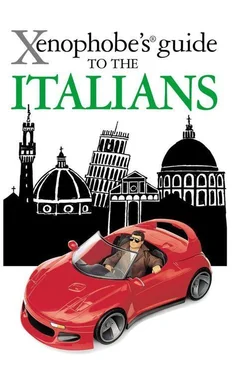Martin Solly - Xenophobe's Guide to the Italians
Здесь есть возможность читать онлайн «Martin Solly - Xenophobe's Guide to the Italians» весь текст электронной книги совершенно бесплатно (целиком полную версию без сокращений). В некоторых случаях можно слушать аудио, скачать через торрент в формате fb2 и присутствует краткое содержание. Год выпуска: 2008, ISBN: 2008, Издательство: Oval Books, Жанр: geo_guides, на английском языке. Описание произведения, (предисловие) а так же отзывы посетителей доступны на портале библиотеки ЛибКат.
- Название:Xenophobe's Guide to the Italians
- Автор:
- Издательство:Oval Books
- Жанр:
- Год:2008
- ISBN:9781908120618
- Рейтинг книги:5 / 5. Голосов: 1
-
Избранное:Добавить в избранное
- Отзывы:
-
Ваша оценка:
- 100
- 1
- 2
- 3
- 4
- 5
Xenophobe's Guide to the Italians: краткое содержание, описание и аннотация
Предлагаем к чтению аннотацию, описание, краткое содержание или предисловие (зависит от того, что написал сам автор книги «Xenophobe's Guide to the Italians»). Если вы не нашли необходимую информацию о книге — напишите в комментариях, мы постараемся отыскать её.
Xenophobe's Guide to the Italians — читать онлайн бесплатно полную книгу (весь текст) целиком
Ниже представлен текст книги, разбитый по страницам. Система сохранения места последней прочитанной страницы, позволяет с удобством читать онлайн бесплатно книгу «Xenophobe's Guide to the Italians», без необходимости каждый раз заново искать на чём Вы остановились. Поставьте закладку, и сможете в любой момент перейти на страницу, на которой закончили чтение.
Интервал:
Закладка:
Italian newspapers are expensive and have a limited readership. Although the average daily circulation is reputed to be under 6.5 million and falling, the actual number of readers is difficult to calculate since many Italians read newspapers available in public places, in the library, the town square or the bar, while others buy more than one newspaper a day.
Most Italian newspapers are serious local papers with a national bent. Others are closely linked to political parties, like Il Giornale to Silvio Berlusconi’s Forza Italia and L’Unità to the Democratic Party of the Left. The daily newspaper with the widest circulation is the Corriere dello Sport which publishes nothing but sporting news, reflecting perhaps the real interest of the Italian public.
“The daily newspaper with the widest circulation publishes nothing but sporting news, reflecting perhaps the real interest of the Italian public.”
For gossip Italians buy glossy weekly magazines where they can read all they want about the world of Hollywood and the British or Monégasque royal families. Despite Italy being the birthplace of the paparazzi , there are few juicy stories about the love-lives and scandals of Italian politicians and people in high places, due to a long-standing tacit agreement between the powers-that-be and the press.
Italy has a fine literary heritage. Famous writers from the past include Dante Alighieri, Boccaccio and Ariosto, while amongst the recent and current are Primo Levi, Italo Calvino, Alberto Moravia, Umberto Eco and Dario Fo. Their works tend to be looked on as ‘great literature’ and, as such, are usually reserved for studying at school, or appreciating on special occasions.
For more general reading, on trains or in bed, the Italians enjoy racy, international, best-selling blockbusters such as Wilbur Smith, Danielle Steel and Dan Brown.
“Perhaps the most successful literary genre in the country which gave the world that much-loved children’s character, Pinocchio , is the comic.”
Some literary genres are colour-coded. Yellow is used for thrillers and detective stories, black for the cronaca nera or crime pages in newspapers and magazines, and pink for romantic novelettes. Italians are not great readers. The fault seems in part to lie with the educational system, but mostly with the ubiquitous television screen: it is hard to read a book and watch television at the same time, and in many houses the television set will be blaring all day and most of the night too.
Perhaps the most successful literary genre in the country which gave the world that much-loved children’s character, Pinocchio , is the comic. Italians adore book-length comics. They are often happiest of all reading the soft porn adventures of their imaginary heroes, like cowboy Tex Willer , sexy fashion victim Valentina , and the off-beat investigator of nightmares and inveterate womaniser, Dylan Dog .
Customs & Tradition
Christmas is traditionally celebrated at home with the family, and Easter is spent with friends: ‘ Natale con i tuoi, Pasqua con chi vuoi ’ (Christmas with your own, Easter with whomever you want). But Easter Monday (called Pasquetta , little Easter) always involves a big family picnic. Never mind that it often rains on Easter Monday (the weather having changed with the Easter moon), this picnic is rarely called off.
“People take time off to do what Italians enjoy most, eating good food and drinking good wine at a leisurely pace in good company.”
Every Italian town and village celebrates its own saint’s day. Milan takes the day off for St. Ambrose, Turin for St. John, Naples for St. Gennaro and Rome for St. Peter.
Most places also have a sagra or festival week devoted to a composer, or food, or a sports event, or an award named after some local poet or politician. These can be on the grand scale, like the great palio (horse race) at Siena, but often they are local affairs, where the people take time off to do what Italians enjoy most, eating good food and drinking good wine at a leisurely pace in good company.
Annual holidays in Italy are mostly taken in August, when the factories in the great northern cities close as the heat of the summer makes city life unbearable, and most families head for the mountains or the seaside to cool down. Life becomes difficult for those who stay behind, as the shops close too, and it isn’t always easy to find the basic necessities of life, while those on holiday do their best to recreate the hustle and bustle of city life on the beach.
“Those on holiday do their best to recreate the hustle and bustle of city life on the beach.”
Other important holidays in Italy include 8th March, when women exchange yellow mimosa and celebrate their pride in being women, 1st May, when half the country is involved in Don Camillo-style first communions and the other half in Peppone-style workers’ parades, and 1st November (All Saints Day), when most Italians take part in serious ancestor worship, visiting their dead in the cemeteries where they repose in multi-decker tombs, stacked one above the other, like so many filing cabinets.
The days before the abstinence of Lent begins on Ash Wednesday are dedicated to celebrating Carnival (from the Latin carnem levare – literally ‘put away meat’), with fancy dress parades and parties climaxing in the Shrove Tuesday ( Martedì Grasso ) festivities, the biggest of which take place in Venice and Viareggio. The Italian Carnival dates back to the pagan Roman feasts of Saturnalia and Lupercalia. For some, Carnival is a time for dressing up as Harlequin or Pulcinella, or dressing up their children and taking them to the parade and the funfair; for others it is a wonderful excuse for behaving outrageously. But Italy’s traditions are no closed shop, in recent years Halloween has enjoyed enormous success as shop windows have filled up with hollowed out pumpkins and whole neighbourhoods have been taken over by miniature witches and wizards.
Many Italians have special privilegi or belong to privileged groups or areas where they pay few taxes, or don’t have to pay taxes at all. Semi-autonomous regions like the Aosta Valley are comparatively happy to remain Italian as long as they continue to receive vast subsidies from central government, only paying, for example, a quarter of the price the rest of Italy pays for petrol.
“Preferential treatment is given to all those in positions of power and authority.”
Italian Members of Parliament and the European Parliament are amongst the highest paid in Europe and also receive preferential treatment wherever they go. The same privilege is given to all those in positions of power and authority, from the members of the local council to the local chief of police. Le autorità (local dignitaries) can count on the fact that for anything that really matters – important football matches or concerts – they have a permanent reservation of the best seats.
The Italians like to think that Italy is a Catholic country, even if they are highly irreverent towards their clergy and tend to ignore papal diktats, such as those concerning birth control (despite the Vatican’s line, Italy has the lowest birth rate in Europe, with an average of 1.2 children per family). Italians can be very ambivalent about their religion.
“Superficially the church’s power is on the wane, yet in terms of real power it might even be stronger than in the past.”
Читать дальшеИнтервал:
Закладка:
Похожие книги на «Xenophobe's Guide to the Italians»
Представляем Вашему вниманию похожие книги на «Xenophobe's Guide to the Italians» списком для выбора. Мы отобрали схожую по названию и смыслу литературу в надежде предоставить читателям больше вариантов отыскать новые, интересные, ещё непрочитанные произведения.
Обсуждение, отзывы о книге «Xenophobe's Guide to the Italians» и просто собственные мнения читателей. Оставьте ваши комментарии, напишите, что Вы думаете о произведении, его смысле или главных героях. Укажите что конкретно понравилось, а что нет, и почему Вы так считаете.












